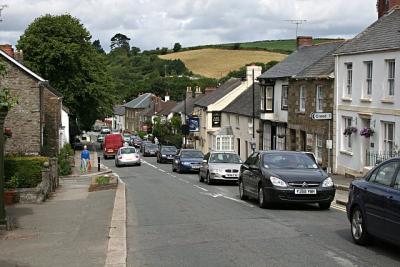


Ancient river crossing point
Web: www.grampound.org.uk
The village of Grampound is at an ancient crossing point of the River Fal and today straddles the A390 road six miles west of St. Austell and eight miles east of Truro. Grampound with Creed is the civil parish of which the village of Grampound and the village of Creed are the main settlements. Formerly, part of Grampound was in the parish of Creed and part was in the parish of Probus. The name Grampound comes from the Norman French: grand (great), pont (bridge), referring to the bridge over the River Fal, with its spelling varying over the last 600 years following the name Ponsmur (Cornish) which was recorded in 1308. The population of Grampound with Creed was 654 in the 2011 census.
The area around Grampound was settled in prehistoric times, and in the early medieval period the parish of Creed and the manor of Tybesta were established here. Grampound grew after the Norman conquest as the main crossing place on the Fal, a focus for travellers and traders moving between west Cornwall and England. Thus Grampound became one of the most important towns in medieval Cornwall with a rich and vibrant history. The bridge from which the town took its name is first recorded in 1296. The first charter was granted by the Earl of Cornwall, John of Eltham in 1332 and the town remained important until the 15th century. Thereafter it declined and John Norden refers to the inhabitants as "few and poore" in his account published in 1584.
The church of St. Nun was built in 1370, the original chapel fell into such a state of disrepair in the 1800's that it became instead the site of livestock sales. Later that century, the efforts of a concerned rector commissioned its rebuilding in 1869 but little of the original remains.
The A390 runs through the centre of Grampound. It is one of Cornwall's few major roads, and in summer when the A30 is congested, the A390 is an alternative route. It is an issue for residents. Pavements in some parts of the village are narrow or non-existent. Traffic speed is an issue through the village. A bypass was considered in 1996, when a route north of the village was favoured, but the plans were rejected, partly due to local protests and partly because Grampound is not large enough to warrant a bypass.
The village possessed a mill, mentioned in the Domesday Book, located at the end of what is still called Mill Lane. In 1501 there were spinning mills, in 1653 fulling mills and later, in 1801, these became woollen manufacturers. From 1816 the industry changed to glove manufacturing.
The tannery industry was important in the past in Grampound. The principal leather tannery, which closed in 2002, was owned by the Croggon family, who still own Creed House, nearby. It consists of several large buildings and surrounding fields on the southern side of the village. This area is being developed into 55 new homes and office space.
The coming of the railway in 1859 by-passed the village completely. The nearest station was at Grampound Road, two miles to the north-west, but this has also now closed.
The new village hall was opened in 2004 with National Lottery funding. This hall is also an arts venue and regularly hosts performances of drama, dance, and music. Notable past performances include the Norwegian percussionist Terje Isungset performing ice music in 2012. A local amateur dramatic group, The Grampound Players, has also performed in recent years.
A small museum, the Grampound with Creed Heritage Centre, is located in the Town Hall.
Throughout the 20th century the rise of the motorcar has had a major impact on the nature of Grampound. The A390 was improved in 1968 with a programme of road widening in which a number of historic buildings in the bridge area were demolished. The 1834 bridge was also demolished and replaced with today's structure.
Landmarks in Grampound include market cross, St. Nun's church, and the Town Hall and clock tower in the centre of the village. A war memorial plaque is on the wall of the town hall. The Dolphin Inn is a little further down the hill. Grampound with Creed Primary School, Grampound Hall, and the recreation ground are near the Fal bridge.
John Hampden (1595–1643), MP for Grampound in 1621 who later, in 1642, was one of the five members whose attempted unconstitutional arrest by King Charles I in the House of Commons of England in 1642 sparked the Civil War.
William Noy (1577–1634), noted British jurist and MP for Grampound 1603–1614,
Charles Wolfran Cornwall (1735–1789), He was Speaker of the House of Commons from 1780 to 1789.
Grey Cooper (1726-1801), MP for Grampound 1768–1774.
Dr William Lindsay Stewart (1901-1975), General Practitioner Grampound from 1923 to 1971. He was treasurer of the Cornwall Division of the BMA, Commander of the Order of St John, Chairman of the Ambulance Sub-committee of Cornwall, Chairman of Grampound parish council, and Councillor for St. Austell Rural District Council and Restormel Borough Council.
Pilkington Jackson (1887–1973) A Scottish sculptor, was born in Grampound.
Grampound Beer Festival - End February
St. Austell Truro Creed House and Garden Trewithen House and Gardens
Probus The Roseland Peninsula Grampound Heritage Centre